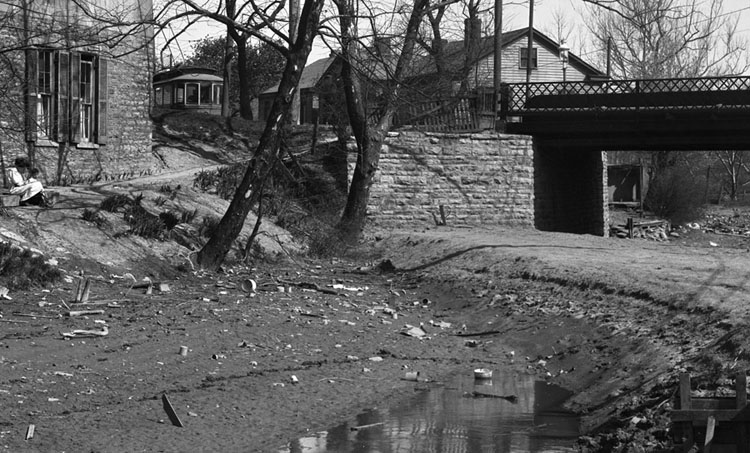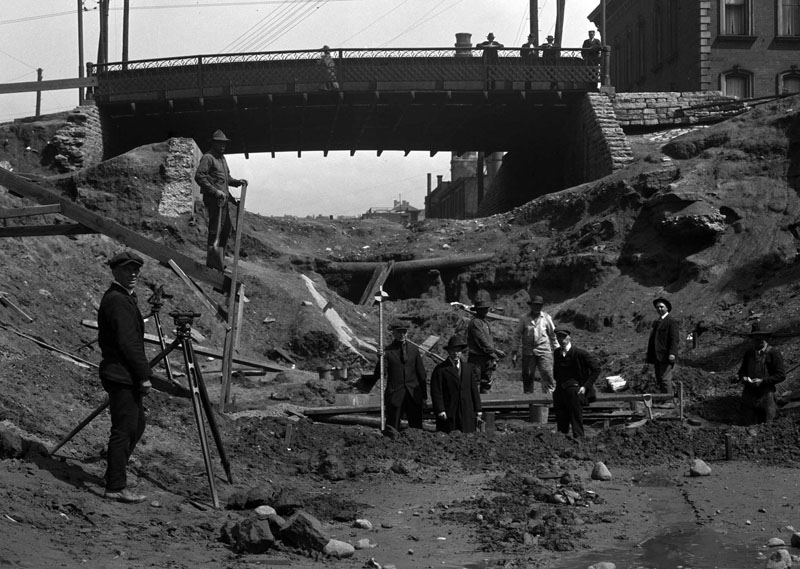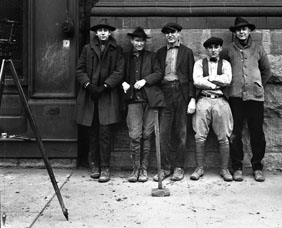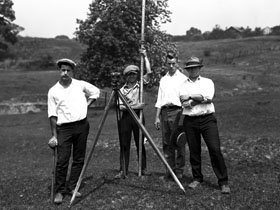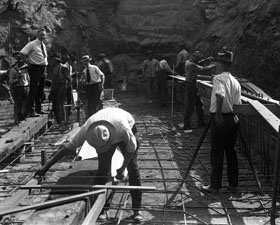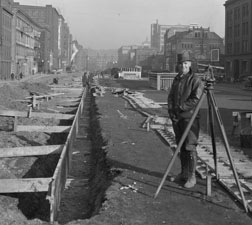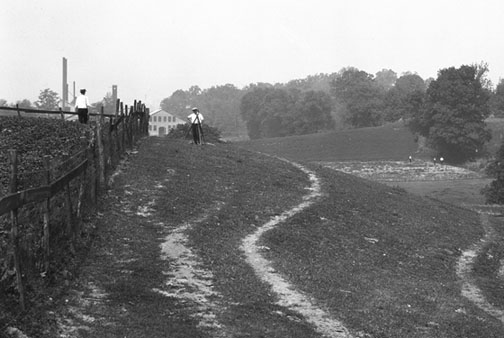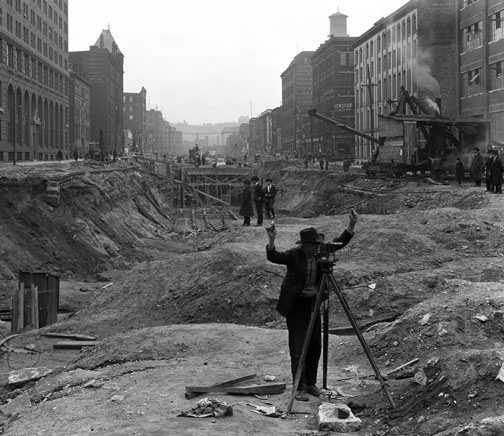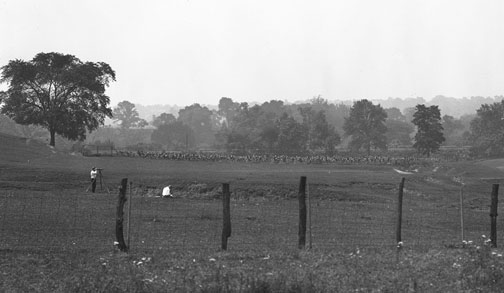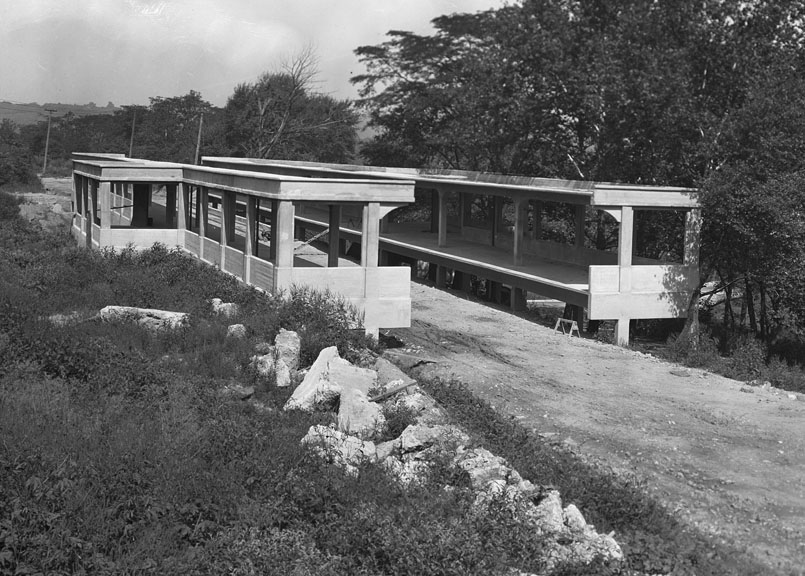By: Angela Vanderbilt
In order for Cincinnati to keep pace with other major cities at the turn of the 20th century, city leaders and citizens recognized that a rapid transit system was necessary for the successful growth and prosperity of Cincinnati. Although several electric street car and interurban railroad lines, as well as horse-drawn streetcars, were utilized for passenger transportation around the city, each line was separately owned and passengers were required to switch from one line to another to reach the downtown business district. A faster, more direct and more efficient means of reaching the downtown was needed.
In 1912, Cincinnati mayor Henry Hunt secured the leasing of the Miami-Erie Canal by the city from the State of Ohio, so that it may be utilized for construction of a proposed rapid transit system. Use of the canal bed for alternate transportation methods had been suggested as early as 1884 in the article “The Dream of the Graphic”, published by the Cincinnati weekly magazine the Graphic, which recommended utilizing the “dead old ditch” as a subterranean rapid-transit system. The magazine featured an artist’s rendering on the cover that depicted a train emerging from a tunnel beneath what had been the canal, now transformed into a grand boulevard.

Artist’s rendering of canal bed repurposed as subterranean transit system with a grand boulevard above. (Image source: http://www.flickr.com/photos/matthunterross/
6613882497/sizes/l/in/photostream/)
Citizens and business owners alike recognized and supported the need for a rapid transit system linking the suburban neighborhoods with the downtown business district, and nearly every citizen supported the removal of the canal which lay stagnant and unused in the early 1900s. Providing a means of fast and efficient access to the downtown was key to the city’s growth, and the most effective reuse of the canal area was to convert it to a boulevard for use by pedestrians and traffic. The incorporation of a subway transit system within the bed of the canal was the most cost-effective means of achieving both goals, and in 1913 the city hired Boston’s Rapid Transit Commission surveyor Professor George F. Swain and City Engineer F. B. Edwards to survey the area and draw preliminary plans.
To accomplish the task of designing and constructing the subway in the old canal bed, teams of engineers were hired to survey the area and develop schemes outlining possible routes and cost estimates. Cincinnati’s City Engineer Frank Krug was appointed in 1914 to oversee the project and engineers were put to work preparing surveys for the proposed routes. Work was halted in 1917 due to the outbreak of World War I, but resumed in 1919, at which time engineers were required to rework the approved these plans in order to reduce costs which had increased during the war.
When construction of the subway commenced in 1920, the teams of engineers and surveyors could be seen down in the trenches or out in the fields, continually ensuring all aspects of construction were accurately performed. Images of the surveyors and engineers working alongside the construction crews can be found throughout the collection. The teams seem to have built a rapport with the construction crews, as well as the photographer, who understood their work was crucial to the success of the project.
Despite the hard work of both engineers and construction crews, the subway would be left unfinished due to circumstances beyond their control. But what was completed, and what still remains, as a result of their hard work and attention to detail is a testament to their skill. Today, only 2.2 miles of tunnels (majority of which runs beneath Central Parkway from Walnut to Hopple Street) and 3 underground stations (Race Street, Liberty and Brighton) remain. The stations continue to be maintained by the city on a regular basis.
This project is funded by a grant for $60,669 through the Library Services and Technology Act, administered by the State Library of Ohio.
Greengard, Samuel. “Workforce 90th Anniversary.” 16 January 2012. Workforce. 31 December 2012 http://www.workforce.com/article/20120116/WORKFORCE90/120109990/playing-it-safe-a-look-at-workplace-safety-during-the-roaring-20s-and-now#.

